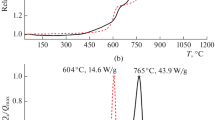Abstract
A number of physical and chemical processes occurring under the action of a laser pulse in nanosized aluminum and aluminized explosives on the basis of fine-grained PETN and benzotrifuroxane along with estimates of the effect of aluminum of the explosive transformation dynamics in these explosives conclude that it is possible to initiate aluminized explosives by laser radiation. The estimated and experimental results show that the main source of hot spots capable of causing an explosive transformation in aluminized explosives under the action of a laser pulse can be a compression wave that forms as a result of rapid evaporation of a sufficient number of aluminum particles. It is shown experimentally that aluminized explosives based on fine-grained RDX and HMX can be initiated by a laser pulse whose source is no more powerful than that in the case of PETN and benzotrifuroxane.
Similar content being viewed by others
References
A. A. Brish, I. A. Galeev, B. N. Zaitsev, et al., “Mechanism of Initiation of Condensed Explosives by Laser Radiation,” Fiz. Goreniya Vzryva 5 (4), 475–480 (1969) [Combust., Expl., Shock Waves 5 (4), 326–328 (1969)].
A. A. Volkova, A. D. Zinchenko, I. V. Sanin, et al., “Time Characteristics of Laser Initiation of PETN,” Fiz. Goreniya Vzryva 13 (5), 760–766 (1977) [Combust., Expl., Shock Waves 13 (5), 645–650 (1977)].
A. I. Bykhalo, E. V. Zhuzhukalo, N. G. Koval’skii, et al., “Initiation of PETN by High-Power Laser Radiation,” Fiz. Goreniya Vzryva 21 (4), 110–113 (1985) [Combust., Expl., Shock Waves 21 (4), 481–483 (1985)].
V. I. Tarzhanov, A. D. Zinchenko, V. I. Sdobnov, et al., “Laser Initiation of PETN,” Fiz. Goreniya Vzryva 32 (4), 113–119 (1996) [Combust., Expl., Shock Waves 32 (4), 454–459 (1996)].
E. D. Aluker, A. G. Krechetov, and B. G. Loboiko, “Effect of Temperature on Laser Initiation of PETN,” Khim. Fiz. 27 (5), 67 (2008).
E. D. Aluker, A. G. Krechetov, A. Yu. Mitrofanov, et al., “Pre-Explosion Stage Duration in Laser Initiation of PETN,” Pis’ma Zh. Tekh. Fiz. 35 (22), 55–561 (2009).
E.D. Aluker, N. L. Aluker, and G. M. Belokurov, “Effectiveness of Laser Initiation of PETN and Its Absorption Spectra,” Khim. Fiz. 29 (1), 49 (2010).
B. P. Aduev, G. M. Belokurov, A. G. Krechetov, et al., “Sensitivity of a Mechanical Mixture of Pentaerythrite Tetranitrate and Ni-C Nanoparticles to Explosion Initiation by Laser Pulses,” Fiz. Goreniya Vzryva 45 (1), 68–72 (2009) [Combust., Expl., Shock Waves 45 (1), 59–63 (2009)].
B. P. Aduev and D. R. Nurmukhametov, “Effect of Additives of Nickel Monocarbide Nanoparticles on PETN Sensitivity to Laser Radiation,” Khim. Fiz. 28 (11), 50–53 (2008).
B. P. Aduev and D. R. Nurmukhametov, “Pressure of Explosive Decomposition Products of a Mixture of PETN and Nickel Monocarbide Nanoparticles in Pulsed Laser Initiation,” Khim. Fiz. 29 (1), 70–74 (2010).
V. N. German, A. K. Fisenko, and N. P. Khokhlov, “Laser Radiation Induced Detonation in HE Samples produced by Thermovacuum Deposition,” in Life Cycles of Energetic Materials Proc. (Fullerton, 1998).
D. V. Mil’chenko, V. A. Gubachev, L. A. Andreevskikh, et al., “Nanostructured Explosives Produced by Vapor Deposition: Structure and Explosive Properties,” Fiz. Goreniya Vzryva 51 (1), 96–101 (2015) [Combust., Expl., Shock Waves 51 (1), 80–85 (2015)].
V. G. Kriger, A. V. Kalenskii, A. A. Zvekov, et al., “Effect of Laser Radiation Absorption Efficiency on the Heating Temperature of Inclusions in Transparent Media,” Fiz. Goreniya Vzryva 48 (6), 54–58 (2012) [Combust., Expl., Shock Waves 48 (6), 705–708 (2012)].
B. P. Aduev and D. R. Nurmukhametov, “Effect of Additives of Ultrafine Al–C Particles on PETN Sensitivity to Laser Radiation,” Khim. Fiz. 30 (3), 63–65 (2011).
E. V. Vlasova, S. M. Bat’yanov, Yu. V. Sheikov, et al., “Results of Studies of Light-Sensitive Explosive Compositions on the Basis of Benzothiophene and [VDT] with Nanoaluminum Under Laser Radiation,” in Proc. XV Khariton Scientific Readings (VNIIEF, Sarov, 2013).
Method for Manufacturing Light-Sensitive Explosive Decompositions and a Light Detonator Based on Them RF Patent No. 2637016 (December 15, 2017).
J. F. Ready, Effects of High-Power Radiation (Academic Press, 1971).
V. I. Tarzhanov, “Preexplosion Phenomena in Prompt Initiation of Secondary Explosives (Review),” Fiz. Goreniya Vzryva 39 (6), 3–11 (2003) [Combust., Expl., Shock Waves 39 (6), 611–618 (2003)].
M. M. Kuklya, E. V. Stefanovich, and A. B. Kunz, “An Exitonic Mechanism of Detonation Initiation in Explosives,” J. Chem. Phys. 112 (7), 65 (2000).
Author information
Authors and Affiliations
Corresponding author
Additional information
Original Russian Text © Yu.V. Sheikov, S.M. Bat’yanov, O.N. Kalashnikova, O.M. Lukovkin, D.V. Mil’chenko, S.A. Vakhmistrov, A.L. Mikhailov.
Published in Fizika Goreniya i Vzryva, Vol. 54, No. 5, pp. 57–64, September–October, 2018.
Rights and permissions
About this article
Cite this article
Sheikov, Y.V., Bat’yanov, S.M., Kalashnikova, O.N. et al. Initiating Aluminized High Explosives by Laser Radiation. Combust Explos Shock Waves 54, 563–569 (2018). https://doi.org/10.1134/S0010508218050088
Received:
Published:
Issue Date:
DOI: https://doi.org/10.1134/S0010508218050088




